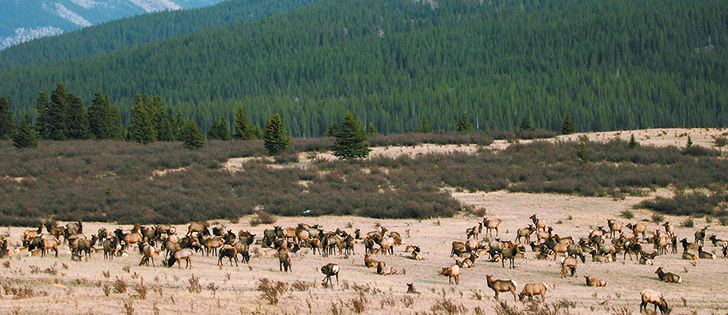Keeping elk out of livestock feed | Fences, highways act as boundaries to keep animals at bay
Some elk roam and some elk take up residence.
Conservation biologist Dale Paton of Anatum Ecological has studied elk movements for six years and has learned the ways and routes of southwestern Alberta’s seven elk herds.
His research will contribute to general knowledge about elk behaviour and may help lessen human-elk conflict and vehicle collisions with migrating animals.
Speaking in the first Wildlife in the Wind presentation sponsored by the Alberta Wildlife Society Oct. 1, Paton said his study area encompassed Chain Lakes to the north, Pincher Creek to the east, Fernie, B.C., to the west and Glacier National Park to the south.
Read Also

Chinese, Indian tariffs take toll on pea prices
The disruption of pea exports from Canada’s largest customers will likely result in slow pea exports for the remainder of the crop year.
Radio collars were affixed to 180 cow elk and young bull elk to track their movements.
Paton was able to identify the summer and winter ranges of migrating elk, their typical stopping points along those routes, and the more limited range of resident herds.
Four of the seven herds migrate, each along a particular route. Their paths include the Whaleback region and Castle-Carbondale to Montana’s Flathead Valley and the B.C.-Alberta Crown of the Continent.
Herds near Waterton and Beauvais Lake Provincial Park, south and west of Pincher Creek, are resident, Paton said.
That is old news to ranchers in the region, who regularly see herds of elk in their fields.
Paton worked with many of them in compiling his research and found ranchers co-operative despite occasional problems with elk eating pasture and hay stacks.
“They understand somewhat the sharing of the land with the elk. Sometimes when there is, in their perception, too many elk, it becomes difficult,” said Paton in a later interview. “The management process they’ve taken seems to be working. Of course you can’t satisfy everyone. But the ranchers were very interested in what we were doing and the elk and where they are going.”
Roger Pisony, who ranches north of Lundbreck, Alta., said he often sees a large herd in his pastures and those of nearby neighbours.
“We live in their country,” he said. “I have no problems with elk. They knock some fences and break some wire and whatnot, and when it’s cold they’ll come down and they’ll want to get to a hay stack. But you can mitigate that by fencing them.”
Fencing proved only a partial solution for Liz Hurst. She and her husband, Bob, also ranch in the area and have lost valued pasture fodder to elk herds in years past.
“You can imagine how disheartening it is when you look out the window and the place is covered in elk, a huge, huge herd of elk, and there’s no getting rid of them. There’s no making them move off,” said Hurst.
“And there goes your pasture that you’ve been so careful to save.”
Elk used to frequent their stored hay until a fencing project solved the problem.
Both Hurst and Pisony said Highway 22 acts as a barrier to elk, which are afraid to cross the busy road.
“It’s actually created a boundary so it keeps the elk off of most of my farmland,” Pisony said.
That meshes with Paton’s research. He has found higher elk traffic on roads that have gates in Alberta’s back country.
“I think there’s a limit to what they can adjust to,” said Paton. He said herds will remain near roads that have fewer than 18 vehicles per day. Beyond that, they are displaced.
Weather plays a major role in elk foraging on farmland and in stacks, noted Pisony.
Cold weather brings herds down from higher ground to forage in more open areas. And once they find an accessible haystack, it’s hard to keep them out even years later. Cow elk seem to retain memories of easy meals in the past.
Alberta Fish and Wildlife offers a compensation program for elk and deer damage, in cases where the producer monitors stacked hay and when that producer has followed department advice and allowed hunting on the property.
Assistance is also available in some cases to erect fencing or use scare devices and repellents.
Paton estimates there are about 3,500 elk in Alberta’s southwest region.
- Scientific name Cervus canadensis.
- Also know as wapiti, which is Shawnee for “white rump.”
- Second largest species in the deer family (moose are the largest).
- Ungulates.
- Bull elk antlers can grow to four feet wide and weigh up to 48 lb.
- Bull elk can weigh up to 1,000 lb.
- Cow elk weigh about one third less than bulls.
- Elk are both grazers and browsers, eating primarily grass, twigs, and leaves.
- Main predators are cougars, wolves, and bears.
- Communicate via squeals, chirps and mews. Males bugle and bark during rutting season.
















